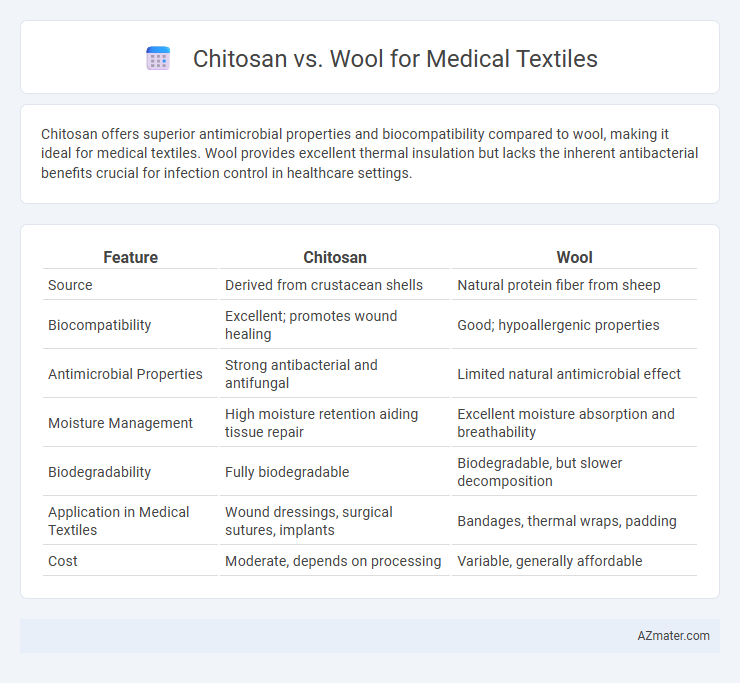Chitosan offers superior antimicrobial properties and biocompatibility compared to wool, making it ideal for medical textiles. Wool provides excellent thermal insulation but lacks the inherent antibacterial benefits crucial for infection control in healthcare settings.
Table of Comparison
| Feature | Chitosan | Wool |
|---|---|---|
| Source | Derived from crustacean shells | Natural protein fiber from sheep |
| Biocompatibility | Excellent; promotes wound healing | Good; hypoallergenic properties |
| Antimicrobial Properties | Strong antibacterial and antifungal | Limited natural antimicrobial effect |
| Moisture Management | High moisture retention aiding tissue repair | Excellent moisture absorption and breathability |
| Biodegradability | Fully biodegradable | Biodegradable, but slower decomposition |
| Application in Medical Textiles | Wound dressings, surgical sutures, implants | Bandages, thermal wraps, padding |
| Cost | Moderate, depends on processing | Variable, generally affordable |
Introduction to Medical Textiles
Medical textiles demand biocompatibility, antimicrobial properties, and durability to ensure patient safety and therapeutic efficacy. Chitosan offers inherent antimicrobial activity and excellent biocompatibility, making it ideal for wound dressings and tissue engineering applications. Wool, while naturally breathable and hygroscopic, lacks the antimicrobial effectiveness and biodegradability required for advanced medical textile applications.
Overview of Chitosan as a Medical Textile
Chitosan, derived from crustacean shells, is a biodegradable polymer with exceptional biocompatibility and antimicrobial properties, making it ideal for medical textile applications such as wound dressings and surgical sutures. Its ability to promote cell regeneration and accelerate healing sets it apart from traditional materials like wool, which lacks these bioactive features despite its natural fiber status. Chitosan's moisture retention and breathability enhance patient comfort while reducing infection risks in clinical environments.
Overview of Wool as a Medical Textile
Wool exhibits unique biomedical properties such as natural breathability, moisture-wicking, and antimicrobial effects, making it suitable for medical textiles used in wound dressings and hospital apparel. Its keratin protein structure promotes skin regeneration and provides thermal insulation, aiding patient comfort and recovery. Despite limited antibacterial efficacy compared to chitosan, wool's biocompatibility and biodegradability remain advantageous in sustainable medical textile applications.
Biocompatibility: Chitosan vs Wool
Chitosan exhibits superior biocompatibility compared to wool, with its natural antimicrobial and wound-healing properties making it ideal for medical textiles. Wool, while biodegradable and comfortable, lacks the inherent bioactive features essential for advanced wound care applications. The enhanced cellular compatibility of chitosan supports tissue regeneration, positioning it as a preferred material in medical textile innovation.
Antimicrobial Properties: Chitosan vs Wool
Chitosan exhibits superior antimicrobial properties compared to wool due to its ability to disrupt bacterial cell membranes and inhibit microbial growth effectively. Wool has inherent antimicrobial characteristics primarily from its lanolin content, but it is less potent and slower acting than chitosan-based textiles. The enhanced antimicrobial efficacy of chitosan makes it a preferred choice for medical textiles requiring robust infection control.
Moisture Management and Breathability
Chitosan fibers exhibit superior moisture management in medical textiles due to their hydrophilic properties, enabling rapid absorption and controlled release of moisture, which reduces bacterial growth and enhances patient comfort. Wool also offers excellent breathability with natural crimp and fiber structure that facilitates airflow and moisture vapor transfer, maintaining a balanced microclimate around the skin. Comparatively, chitosan-infused textiles provide enhanced antimicrobial benefits alongside moisture regulation, while wool excels in thermal insulation combined with effective moisture wicking.
Biodegradability and Environmental Impact
Chitosan exhibits superior biodegradability compared to wool, as it is derived from natural polysaccharides that decompose rapidly without toxic residues, making it ideal for eco-friendly medical textiles. Wool, while biodegradable, degrades more slowly due to its protein-based structure and often requires energy-intensive processing that impacts the environment. The environmental footprint of chitosan in medical textiles is lower, promoting sustainable waste management and reduced ecological toxicity during production and disposal.
Mechanical Strength and Durability
Chitosan fibers exhibit superior mechanical strength compared to wool, with tensile strength values often exceeding 300 MPa, making them ideal for medical textiles requiring durability and resistance to deformation. Wool's natural crimp structure provides elasticity but lower tensile strength, around 100-150 MPa, which may limit its long-term durability under continuous stress in clinical applications. The biodegradability and antimicrobial properties of chitosan enhance its functional lifespan, ensuring sustained performance in wound dressing and surgical textiles over traditional wool-based materials.
Cost and Scalability in Medical Applications
Chitosan-based medical textiles offer superior biocompatibility and antimicrobial properties but often come with higher production costs due to complex extraction and purification processes. Wool, while more affordable and widely available, lacks inherent antimicrobial features and requires additional treatments to meet medical standards. Scalability favors wool textiles because of established supply chains and lower raw material costs, whereas scaling chitosan materials remains limited by sourcing challenges and batch variability.
Future Prospects and Innovations
Chitosan exhibits remarkable biocompatibility, antimicrobial properties, and biodegradability, making it a promising material for advanced medical textiles, especially in wound dressings and infection control. Wool, valued for its natural insulating and moisture-wicking capabilities, is evolving with nanotechnology enhancements to improve comfort and functionality in healthcare apparel. Innovations focus on integrating chitosan's bioactive capabilities with wool's thermal regulation to create hybrid textiles that support patient recovery and hygiene in medical environments.

Infographic: Chitosan vs Wool for Medical textile
 azmater.com
azmater.com